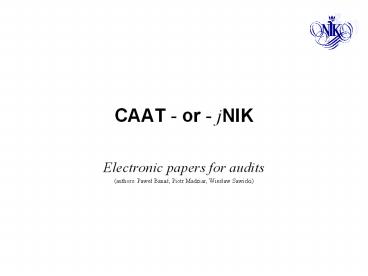CAAT or jNIK - PowerPoint PPT Presentation
1 / 20
Title: CAAT or jNIK
1
CAAT - or - jNIK
- Electronic papers for audits
- (authors Pawel Banas, Piotr Madziar, Wieslaw
Sawicki)
2
Tradition
- Supreme Chamber of Control 1919
- roots in early XIX century
- indispensable element of modern democratic Poland
3
Complex Audit Procedure
- most audits are multi-location type
- documents
- Audit Plan
- Protocol (per location)
- Management letter (per location)
- Report
- quality requirements sometimes resulted in
massive documents
4
Figure 1 General Scheme of the NIK Audit
Procedure documents produced and archived in
MSWord format
Planningrisk assessment analysis of external
information and documents of NIK
no
yes
Decisionof theNIK Board
Audit Procedures
Audit Procedures
Audit Plandraft
Protocol
Protocol
no
no
Appeal Phase
Appeal Phase
MS Word
yes
yes
ManagementLetter
ManagementLetter
NIK Report
no
no
Appeal Phase
Appeal Phase
yes
5
Computerisation Financial CAAT
- mid-90s NIK underwent rapid computerisation
- late 90s NIK has been using CAATs
- Auditor Assistant
- other basic computing tools
6
More needed
- IT tool most extensively used MSWord
- not calibrated for the auditor needs
- auditor has to play the role of a professional
brochure-maker - problem with internal or bilateral documents
- focus the attention on the content
- simplest solution calibration of the MSWord
- standardize the documents layouts,
- easy retrieve analytical data with styles and
pre-made macros
7
Is Word Processor a CAAT?
- can hardly be a CAAT in financial audit
- can be much more a CAAT in the performance or
VFM audit
8
Desired Functions and Features
- replace an empty page with a flexible
electronic form - free the auditor from the duty of text formatting
- treat audit documents as data collections
- free our data repositories from formatting code
of word processor
9
Flexible and Open Source
- no solution available on the market
- something much more flexible then the product
prêt-a-porter - many difficulties in construction
- the risk that the new tool will deform our way of
work - the long and expensive process of outsourcing our
individual project - XML and Java
10
CAAT or jNIK technology
- first version of CAAT-or- jNIK Summer 2003
- technology of jNIK
- user interface is written in Java Swing
- internal XML processing is based on DOM standard
being part of JAXP - tree with each branch connected to e-form (part
of the XML file) - XML file can be
- full Audit Plan, next used as the Protocol
- visualised in HTML, PDF format
11
Figure 2 Technology of jNIK.
JAVA
HTML
SWING
DOM
XML
XSLT
12
CAAT or jNIK key features
- e-form, not text editor
- disciplines the audit teams to relate to all
points in the Audit Plan - means much more easier screening of the teams
work - organizes and stores the data as XML documents
13
Figure 3 The Audit Plan view
14
Figure 4 The Protocol view
15
Figure 5 Printout of Protocol
16
Hierarchy of Document
- dictionary of XML elements and limit the number
of levels - 3-level hierarchy of the Audit Plan
- auditee(s)
- areas
- subjects
- next levels of the problem branches
- groups of findings
- findings
17
Results
- user obtains a set of XML data
- Audit Plan
- Protocol
- elements to construct the Management Letter and
the Report - much less disc space that MSWord files
- light software
- applied to the SCC audit procedure
- ... but very flexible
18
Figure 6. General Scheme of the NIK Audit
Procedure use of jNIK and MSWord
Planningrisk assessment analysis of external
information and documents of NIK
Audit Plandraft
final versionxhtml / pdf
Decisionof theNIK Board
no
jNIK
yes
Audit Procedures
Audit Procedures
Protocol
Protocol
final versionxhtml / pdf
data reports
no
no
Appeal Phase
Appeal Phase
findings
yes
yes
ManagementLetter
ManagementLetter
XML to Word
no
no
Appeal Phase
Appeal Phase
NIK Report
Analytical Data
Word to XML
yes
MS Word
19
Conclusions
- fits into real needs of the organisation
- cost-free
- home-grown support team to fill gaps
- supports open source environment
- more money on IT training
20
Future plans
- gain fully stable version
- internationalization of the Java code
- make jNIK publicly available by GPL licence































